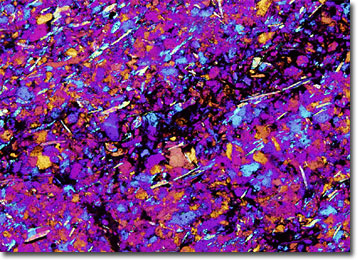Polarized Light Microscopy Digital Image Gallery
Ferruginous Argillite
Argillite is a kind of sedimentary or slightly metamorphosed rock that is generally considered an intermediate between shale and slate. It typically occurs in shades of bluish- or grayish-black and is best known for its use as a carving material.

Argillite is primarily composed of clay or silt particles, but may contain other constituents as well. When iron is present, the rock is commonly referred to as a ferruginous argillite. This type of argillite may be found in various locales, such as Missoula, Montana and Killarney Park in Ontario, Canada. A siliceous kind of argillite, on the other hand, is commonly known as zebra rock due to the alternating red and cream-colored bands it exhibits. An unusual sight to behold, occurrences of zebra rock argillite are only known in Western Australia.
The practice of carving argillite is a tradition of the Haida people, a group of Native Americans that inhabit the Queen Charlotte Islands of British Columbia, Canada. The argillite deposits they traditionally exploited for this use are located along Slatechuck Mountain, near the island village of Skidegate. When quarried, the rocks contain significant amounts of water, and the Haida often wrapped them in wet cloth in order to keep them soft for carving. When dry, argillite is somewhat brittle and old carvings from the material are very fragile. Nevertheless, if they are carefully preserved, these works of art may survive undamaged for lengthy periods of time. In recent years, a renewed interest in Haida carvings has developed and newly made argillite pieces are often sold as souvenirs.
